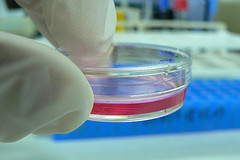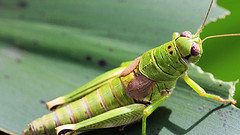Introduction
 Food - we all need it and we can’t live without it. As the world’s population grows every minute, there are more and more mouths to feed. In fact, there are so many mouths to feed that ‘overpopulation’ is now a big concern for our planet’s future. In 2050 there are expected to be an extra 2.5 billion people on earth.
Food - we all need it and we can’t live without it. As the world’s population grows every minute, there are more and more mouths to feed. In fact, there are so many mouths to feed that ‘overpopulation’ is now a big concern for our planet’s future. In 2050 there are expected to be an extra 2.5 billion people on earth.
Why do we need to think about new food sources? Our food is grown all over the world in vast fields and millions of greenhouses and all this takes up a lot of space - something which is already limited. In the UK alone farming accounts for about 70% of the land area. Also, don't forget that all vegetables, fruits and animals (meat) need food and water of their own to grow and all of this puts a lot of pressure on the earth.
How much meat do you eat in a week? Many people eat meat every day, whether it is ham in a sandwich, chicken nuggets, sausages, a pepperoni pizza or spaghetti bolognese. It is predicted that the world's demand for meat will double in the next 40 years and this might be a problem...
Laboratory Meat
 Cultured meat is a term used for meat products that are grown in a laboratory from cells in a new type of 'farming' called cellular agriculture.
Cultured meat is a term used for meat products that are grown in a laboratory from cells in a new type of 'farming' called cellular agriculture.
Why do this? All the animals that we need to provide our food require a lot of space, food and water and some of these animals also create a lot of gas! Methane is a gas produced by cows, pigs and sheep and is said to be one of biggest contributions to greenhouse gas emissions. Greenhouses gases are gases that stay high up in the sky to form an invisible blanket around the earth, trapping heat in the atmosphere and causing what is known as global warming. To solve all of these problems scientists have been growing muscles (the part of the animal we eat) in laboratories using tiny microscopic cells.
Our bodies are made up of billions of cells and some of these are called stem cells. Stem cells are what help develop babies in the womb and in adults they help to repair damage to the body. Stem cells can repeat themselves over and over and this is how scientists are growing steaks in plastic dishes. Stem cells are taken from live animals without harming them and then these tiny particles can be put into the laboratory and under the right conditions a muscle will grow.
The first 'no kill' burger was created in a lab in 2013, but, in those early days of the technology, the process took two years to perfect and the resulting burger cost $300,000 (£226,882) to produce! By 2016, a company called Memphis Meats produced a $1000 (£756) meatball and, in 2020, a US company called Eat Just received safety approval from Singapore to release it's cultured, lab-grown 'chicken bites'. The cells for the 'chicken' are grown in a 1,200-litre bioreactor and then mixed with plant-based ingredients. Although the bites will only be available in Singaporean restaurants at first, and will be relatively expensive, Eat Just claims that future products will be cheaper than chicken raised from animals.
This raises interesting debates as to whether lab-grown meat would be suitable for vegetarians to eat, since it will not have involved harming any live animals.
Insects
Grasshopper burger anyone?

The Oxford University Museum of Natural History is promoting one answer to the growing food demand - a diet of bugs. So, why creepy crawlies? Well first we need to take a look at what we eat now. Here in the UK we eat a lot of meat and the animals that provide that meat have to grow up somewhere. Right now there are cows, pigs and sheep eating food and drinking water just to get onto our plates for dinner. But the world’s meat farms can’t keep up with a growing population.
Now imagine if we ate insects - they need less space, less food, less water and this makes insect farming much more sustainable. An insect farm wouldn’t need to clear a lot of land to grow food for the insects, they wouldn’t need tractors, fertilisers and all of these things that cause carbon dioxide emissions and damage to the environment. Also, insects don’t fart and create methane (a greenhouse gas) like a whole field of cows!
But are they any good for us? Yes! Insects, although tiny compared to a beef steak contain a lot of protein and are low in calories. For a lot of people, eating insects isn’t a new thing it’s a tradition. There are thousands of insects being eaten by about 2.5 billion people who live in countries such as Africa and Asia. Some of the meals eaten across the world include cheese with live maggots, grilled dragonflies and baked tarantula.
So, if they’re as healthy as meats, cause less damage to the environment and can help feed the earth then there’s no question - insects could soon be coming to a restaurant near you!
Algae
 Algae is the green slime you see in ponds or in a fish tank and the long brown/red/green strands of seaweed you see on the beach or in rockpools. Already millions of people around the world eat seaweed from Japan to Chile, South Africa to Belize and even in England. In fact you've probably eaten food with seaweed in it and not noticed it as chemicals from seaweed are used in many sweets, desserts, meat products and even drinks!
Algae is the green slime you see in ponds or in a fish tank and the long brown/red/green strands of seaweed you see on the beach or in rockpools. Already millions of people around the world eat seaweed from Japan to Chile, South Africa to Belize and even in England. In fact you've probably eaten food with seaweed in it and not noticed it as chemicals from seaweed are used in many sweets, desserts, meat products and even drinks!
The benefits of seaweed are many. It is very nutritious as it has lots of good minerals and vitamins for the body. These include vitamin A, which helps fight off colds and viruses and calcium which is good for your bones and teeth. Seaweed is also easy to grow and doesn't take up precious land space as it's grown in water. It grows quickly and can even grow in polluted waters and in places where normal food crops wouldn't survive.
Algae facts -
- Algae is the most important organism on earth as it provides nearly all of earth's oxygen which we need to breathe!
- Algae is eaten by everything from the tiniest shrimp to the largest living animal, the blue whale.
- The first plants on earth evolved from shallow freshwater algae some 400 million years ago
- Fuels used in cars and aeroplanes may be powered by algae in the future.
- Algae can also be grown as feed for animals and as fertiliser to spread on soil and help crops grow.
Credits
Image: Food of the Future by CIAThttps://www.flickr.com/photos/ciat/
 Food - we all need it and we can’t live without it. As the world’s population grows every minute, there are more and more mouths to feed. In fact, there are so many mouths to feed that ‘overpopulation’ is now a big concern for our planet’s future. In 2050 there are expected to be an extra 2.5 billion people on earth.
Food - we all need it and we can’t live without it. As the world’s population grows every minute, there are more and more mouths to feed. In fact, there are so many mouths to feed that ‘overpopulation’ is now a big concern for our planet’s future. In 2050 there are expected to be an extra 2.5 billion people on earth.
 Cultured meat is a term used for meat products that are grown in a laboratory from cells in a new type of 'farming' called cellular agriculture.
Cultured meat is a term used for meat products that are grown in a laboratory from cells in a new type of 'farming' called cellular agriculture.
 Algae is the green slime you see in ponds or in a fish tank and the long brown/red/green strands of seaweed you see on the beach or in rockpools. Already millions of people around the world eat seaweed from Japan to Chile, South Africa to Belize and even in England. In fact you've probably eaten food with seaweed in it and not noticed it as chemicals from seaweed are used in many sweets, desserts, meat products and even drinks!
Algae is the green slime you see in ponds or in a fish tank and the long brown/red/green strands of seaweed you see on the beach or in rockpools. Already millions of people around the world eat seaweed from Japan to Chile, South Africa to Belize and even in England. In fact you've probably eaten food with seaweed in it and not noticed it as chemicals from seaweed are used in many sweets, desserts, meat products and even drinks!